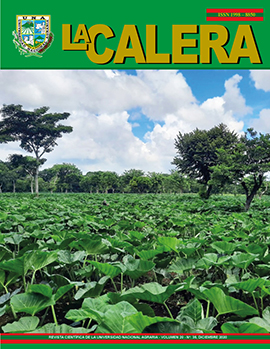Sistema agroforestal Quesungual como fuente natural de emisiones de gases de efecto invernadero en la microcuenca Tecomapa, Somotillo-Nicaragua
DOI:
https://doi.org/10.5377/calera.v20i35.10217Palabras clave:
metano, óxido nitroso, cambio climáticoResumen
Con el propósito de evaluar las emisiones de metano y óxido nitroso en el suelo a través del método de cámaras estáticas cerradas en tres sistemas de uso; bosque secundario, sistema agroforestales Quesungual y sistema tradicional agrícola, en la micro cuenca Tecomapa, Somotillo, Nicaragua, setenta y dos cámaras estáticas cerradas fueron establecidas en seis fincas localizadas en la unidad hidrográfica Tecomapa, Nicaragua en 2014, para evaluar las emisiones de Metano (CH4) y Óxido Nitroso (N2O), en los sistemas de uso de suelo: Bosque secundario, Quesungual y Sistema Tradicional agrícola. Como resultado, mayores emisiones de N2O y CH4, se observaron en el mes más lluvioso (septiembre 2014). El sistema Quesungual fue sumideros de CH4 a nivel de flujos netos acumulados (p>F=0.0133), y el sistema tradicional el mayor emisor de este gas. La mayor emisión de N2O tiende a ocurrir en el sistema tradicional. Finalmente el gas metano se asoció positivamente al N2O (r2= 1; p>F= 0.0533), y el WFPS tiende a asociarse negativamente a la temperatura y gases CH4 y N2O.
Descargas
683
HTML 473
EPUB 234

